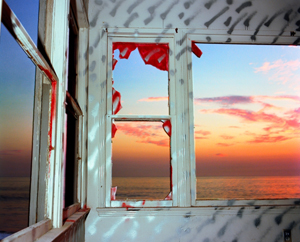2.21.25 — Swimming in Light
John Divola keeps returning to abandoned buildings in California for the sunsets, a photographer’s studio, and almost, just almost a sense of home. Any one of these is just a hole in the wall, with many real holes in its walls, but his photography fills them with a history and with light.
Like his show at the same gallery just three years ago, he draws on two series, one from many years past now, with much of the same geography. He is bolder than ever with his own additions and manipulations, at Yancey Richardson through February 22, to the point that sunrise or early evening light seems to shine right through those holes. He again makes one take stock of nature and culture. Still, rather than start again on a review, allow me to draw on my old one, revised in light of the new, so here goes. You still may look twice at those holes to know whether you are inside looking out or outside looking in. 
Some things never change. When Divola exhibits two series together, from forty years apart, one could merge their one-word titles into a single revelation, Zuma Daybreak. In the first, photos overflow with light and color from sky and sea. The view from an abandoned building can hardly contain them, although windows and walls have an intensity of their own. And then a second series turns to black and white with much the same perplexity of inside and out, rebirth and decay. If you no longer know which is which, the photographer himself, the show’s title has it, is “Swimming Drunk.”
Daybreak here lasts a long time. Divola came upon the first property in 1977, in his late twenties, and he kept returning to it over the course of a year. It stood in Zuma Beach, in Malibu, better known for expanses of sand and surf than for abandonment, but they flow easily together. Photography can transform one into the other at that. Churning waters all but merge with the the ratty frame of a door or window. Interior light and paint compete with the white of clouds and sky. Together, they send the ultimate in mixed messages—but then Neil Young, who recorded Zuma two years earlier, had an aversion to unspoiled pleasure, too.
Divola persisted through the course of a day, from the crack of dawn to afternoon sunlight and a wilder sunset. As months passed, he made his own additions as well, including spray paint and artificial lighting, for patterns that seem to float or to burst off the walls. He had an assist from vandalism, wear and tear, and the fire department, which had used the building for training exercises. It is hard to know who took an axe to particular scenes—they, the photographer, or no one at all. Nature and human intervention each has its glorious excess, while the sobriety of black paint and interior shadows helps rein an unnatural nature in. So does the grid of architecture and windows.
A second series makes use of smaller sheets, the kind used for contact prints, in a gallery room often set aside for a different artist entirely. One could mistake it for Divola’s first approach to the theme or his inspiration in photography’s past. That would overlook how color entered the mainstream precisely in the 1970s, thanks to such photographers as William Eggleston and Stephen Shore who harped on saturated hues and unnatural light. That was also the time of Minimalism and the grid. Divola largely abandons those points of reference for “Daybreak” in black and white. He began in 2015, right after a show on very different themes, and he took until 2020 to complete the series. Still, one can wonder just how much in forty years has changed.
The setting in an abandoned building is back, but more confining, and his interventions intensify. Graffiti is that much harder to tell from a shower of sunlight or a density of shadow. Windows are fewer, and he may give over a print to an interior wall draped with what might pass for a work of art. Rather than a grid, it may display raw cuts like those of Lucas Samaras in paint. Samaras, though, never shreds the display space or calls it home. In the course of five years, Divola has made the room his studio, and a ghostly self-portrait appears faintly at least once.
It is still swimming in light and excess, though without the sea. Divola has moved inland to a cold war relic and abandoned air force base, for “The Ghost in the Machine.” Where the earlier series has the color of a psychedelic dream, this scene looks like a war zone, apart from bursts of sunlight, vegetation, and his own startling sprayed colors showing through real holes in the walls. In reality, it was once housing for men on the way to war. The one bit of verbal graffiti calls it Sleep Without Dreams. It is past daybreak all the same.
Read more, now in a feature-length article on this site.